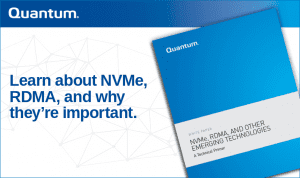Re-Imagining Quantum’s Portfolio for Managing Unstructured Data
ActiveScaleThis week, we made a significant announcement, introducing an expanded portfolio focused on classifying, managing, and protecting unstructured data across its lifecycle. The new products we introduced represent another significant step in our vision to lead in video and unstructured data solutions and represent a key shift in focus from ‘storing’ data to ‘managing’ data.
Accelerating Data Growth, Data Movement, and Use of Hybrid- and Multi-Cloud
Our customers are dealing with massive unstructured data sprawl – video, digital images, and other forms of unstructured data are growing by 30-60% per year. Many of our customers have millions or billions of files and lack visibility into what they have, and where it lives. This lack of visibility combined with the velocity of data growth is putting pressure on infrastructure costs and forcing companies to rethink infrastructure designs.
At the same time, the COVID pandemic has resulted in permanent changes to the workforce, driving more data movement (between edge / core / cloud), and an acceleration in the adoption of hybrid-cloud and multi-cloud. The emergence of AI and machine learning techniques provide new tools to leverage this data, and is also driving new lifecycle and ‘workflow’ requirements for this data, including a desire to preserve and protect this data and keep it accessible for decades.
All of this adds up to what we see as the key challenge facing our customers in this decade – how to unlock business value out of all of this data, and manage this data across the entire multi-decade lifecycle of this data.
Manage Unstructured Data, Across Any Workload, End-to-End with Quantum
Our expanded portfolio can help our customers tackle this challenge, starting with new ways to classify and manage data across its lifecycle, for any workload, end-to-end. This expanded portfolio is depicted and summarized below:

The new announcements include:
- New ways to visualize, automate, and purposefully place data, with Quantum’s All-Terrain File System (ATFS) , a next-gen storage platform targeted at the NAS market.
- StorNext 7 : The latest version of Quantum’s high-performance file system, for high throughput low-latency workloads. StorNext 7 introduces new features like file system pools that optimize the use of NVMe for production storage, as well as new ways to program and manage the file system.
- An expanded ActiveScale object storage portfolio , including a new 3-node object storage system, object lock to protect against ransomware, and small object aggregation to improve the performance of small objects.
Lastly, all of these new offerings are available on a capacity basis, with new all-inclusive software licensing that aligns our licensing with the value we are delivering to customers.
We look forward to engaging with customers and partners on this expanded portfolio – to learn more, please register for our VirtualQ I Transform event where we will be showcasing all of these new solutions.




 The technology industry is notable for a variety of reasons. It represents 7 out of the top 10 publicly traded firms ranked by market capitalization. In the past half-century, it is responsible for more of the advancements that have changed the way we live and work than any other industry. And finally, although this may be subjective, there is no other industry that uses more acronyms than ours. I could fill an entire book dedicated to decoding and explaining the myriad acronyms used in technology. However, since I don’t have time to do that, I’ll focus on two that represent some of the hottest technologies in storage today – NVMe and RDMA.
The technology industry is notable for a variety of reasons. It represents 7 out of the top 10 publicly traded firms ranked by market capitalization. In the past half-century, it is responsible for more of the advancements that have changed the way we live and work than any other industry. And finally, although this may be subjective, there is no other industry that uses more acronyms than ours. I could fill an entire book dedicated to decoding and explaining the myriad acronyms used in technology. However, since I don’t have time to do that, I’ll focus on two that represent some of the hottest technologies in storage today – NVMe and RDMA.